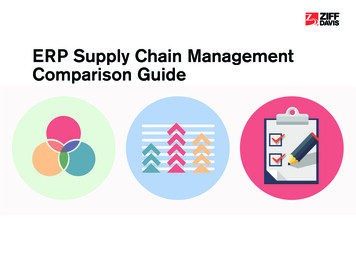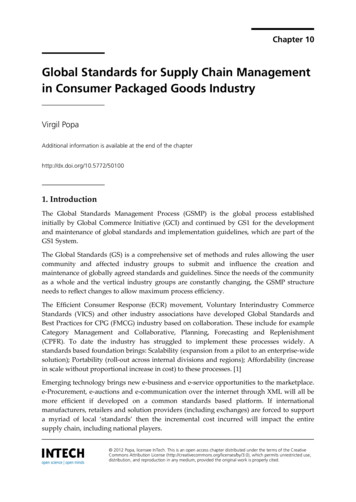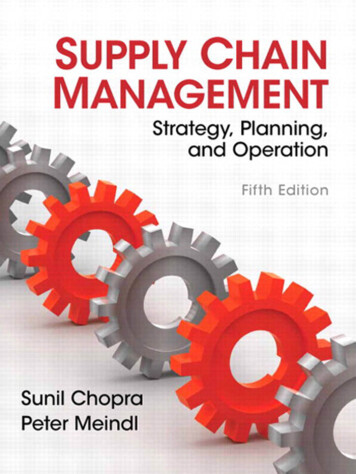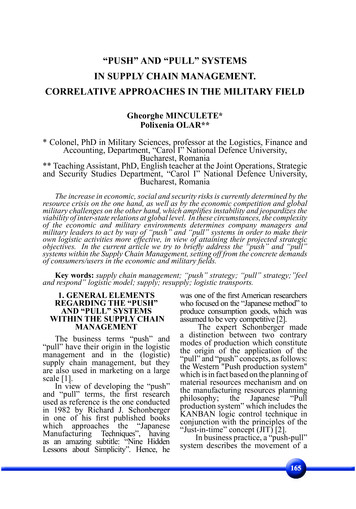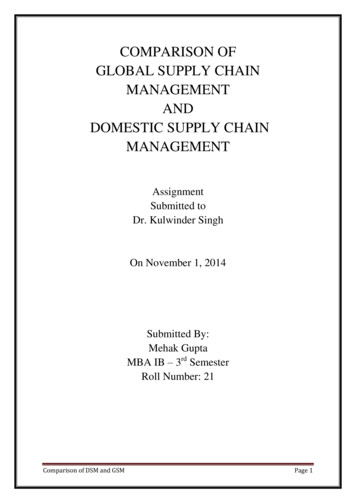
Transcription
COMPARISON OFGLOBAL SUPPLY CHAINMANAGEMENTANDDOMESTIC SUPPLY CHAINMANAGEMENTAssignmentSubmitted toDr. Kulwinder SinghOn November 1, 2014Submitted By:Mehak GuptaMBA IB – 3rd SemesterRoll Number: 21Comparison of DSM and GSMPage 1
SUPPLY CHAIN MANAGEMENTSupply chain management (SCM) is the management of the flow of goods, flow of cash, andflow of information internally and externally of a company or a group of companies thatshare the same value chain. It includes the movement and storage of raw materials, work-inprocess inventory, and finished goods from point of origin to point of consumption; cash orcredit in purchasing or selling of products or services; as well as the information thatconducts those activities, such as orders, demand forecast, or even picking lists.Interconnected or interlinked networks, channels and node businesses are involved in theprovision of products and services required by end customers in a supply chain. .Comparison of DSM and GSMPage 2
Supply Chain Management (SCM) is the management of the relationship between thesupplier's supplier and the customer's customer through the supply chain participants(Distributor/Wholesaler and Retailer) between them, mainly using information flow andlogistics activities to gain Competitive advantage and customer satisfaction.A supply chain, as opposed to supply chain management, is a set of organizations directlylinked by one or more upstream and downstream flows of products, services, finances, orinformation from a source to a customer. Supply chain management is the management ofsuch a chain.Supply chain management software includes tools or modules used to execute supply chaintransactions, manage supplier relationships, and control associated business processes.Supply chain event management (SCEM) considers all possible events and factors that candisrupt a supply chain. With SCEM, possible scenarios can be created and solutions devised.In many cases the supply chain includes the collection of goods after consumer use forrecycling. Including third-party logistics or other gathering agencies as part of the RM repatriation process is a way of illustrating the new endgame strategy.FUNCTIONS OF SCMSCM is a cross-functional approach that includes managing the movement of raw materialsinto an organization, certain aspects of the internal processing of materials into finishedgoods, and the movement of finished goods out of the organization and toward the endconsumer. As organizations strive to focus on core competencies and becoming moreflexible, they reduce their ownership of raw materials sources and distribution channels.These functions are increasingly being outsourced to other firms that can perform theactivities better or more cost effectively. The effect is to increase the number of organizationsinvolved in satisfying customer demand, while reducing managerial control of daily logisticsoperations. Less control and more supply chain partners led to the creation of the concept ofsupply chain management. The purpose of supply chain management is to improve trust andcollaboration among supply chain partners, thus improving inventory visibility and thevelocity of inventory movement.Comparison of DSM and GSMPage 3
Main functions of Supply Chain Management are as follows: Inventory Management Distribution Management Channel Management Payment Management Financial Management Supplier Management Transportation Management Customer Service ManagementIMPORTANCE OF SCMOrganizations increasingly find that they must rely on effective supply chains, or networks, tocompete in the global market and networked economy. In Peter Drucker's (1998)management paradigms, this concept of business relationships extends beyond traditionalenterprise boundaries and seeks to organize entire business processes throughout a valuechain of multiple companies.In recent decades, globalization, outsourcing, and information technology have enabled manyorganizations, such as Dell and Hewlett Packard, to successfully operate collaborative supplynetworks in which each specialized business partner focuses on only a few key strategicactivities (Scott, 1993). This inter-organisational supply network can be acknowledged as anew form of organisation. However, with the complicated interactions among the players, thenetwork structure fits neither “market” nor "hierarchy" categories (Powell, 1990). It is notclear what kind of performance impacts different supply network structures could have onfirms, and little is known about the coordination conditions and trade-offs that may existamong the players. From a systems perspective, a complex network structure can bedecomposed into individual component firms (Zhang and Dilts, 2004). Traditionally,companies in a supply network concentrate on the inputs and outputs of the processes, withlittle concern for the internal management working of other individual players. Therefore, thechoice of an internal management control structure is known to impact local firmperformance (Mintzberg, 1979).In the 21st century, changes in the business environment have contributed to the developmentof supply chain networks. First, as an outcome of globalization and the proliferation ofComparison of DSM and GSMPage 4
multinational companies, joint ventures, strategic alliances, and business partnerships,significant success factors were identified, complementing the earlier "just-in-time", leanmanufacturing,and agilemanufacturing practices.Second,technologicalchanges,particularly the dramatic fall in communication costs (a significant component of transactioncosts), have led to changes in coordination among the members of the supply chain network(Coase, 1998).Many researchers have recognized supply network structures as a new organisational form,using terms such as "Keiretsu", "Extended Enterprise", "Virtual Corporation", "GlobalProduction Network", and "Next Generation Manufacturing System". In general, such astructure can be defined as "a group of semi-independent organisations, each with theircapabilities, which collaborate in ever-changing constellations to serve one or more marketsin order to achieve some business goal specific to that collaboration" (Akkermans, 2001).The security management system for supply chains is described in ISO/IEC 28000 andISO/IEC 28001 and related standards published jointly by the ISO and theIEC. Supply ChainManagement draws heavily from the areas of operations management, logistics, procurement,and information technology, and strives for an integrated approach.BUSINESS PROCESS INTEGRATIONSuccessful SCM requires a change from managing individual functions to integratingactivities into key supply chain processes. In an example scenario, a purchasing departmentplaces orders as its requirements become known. The marketing department, responding tocustomer demand, communicates with several distributors and retailers as it attempts todetermine ways to satisfy this demand. Information shared between supply chain partners canonly be fully leveraged through process integration.Supply chain business process integration involves collaborative work between buyers andsuppliers, joint product development, common systems, and shared information. According toLambert and Cooper (2000), operating an integrated supply chain requires a continuousinformation flow. However, in many companies, management has concluded that optimizingproduct flows cannot be accomplished without implementing a process approach. The keysupply chain processes stated by Lambert (2004) are: Customer relationship managementComparison of DSM and GSMPage 5
Customer service management Demand management style Order fulfilment Manufacturing flow management Supplier relationship management Product development and commercialization Returns managementBest-in-class companies have similar characteristics, which include the following: Internal and external collaboration Initiatives to reduce lead time Tighter feedback from customer and market demand Customer-level forecastingOne could suggest other critical supply business processes that combine these processesstated by Lambert, such as:a. Customer service managementb. Procurementc. Product development and commercializationd. Manufacturing flow management/supporte. Physical distributionf. Outsourcing/partnershipsg. Performance measurementh. Warehousing managementa) Customer service management processCustomer relationship management concerns the relationship between an organization and itscustomers. Customer service is the source of customer information. It also provides thecustomer with real-time information on scheduling and product availability through interfaceswith the company's production and distribution operations. Successful organizations use thefollowing steps to build customer relationships: determine mutually satisfying goals for organization and customers establish and maintain customer rapportComparison of DSM and GSMPage 6
induce positive feelings in the organization and the customersb) Procurement processStrategic plans are drawn up with suppliers to support the manufacturing flow managementprocess and the development of new products. In firms whose operations extend globally,sourcing may be managed on a global basis. The desired outcome is a relationship where bothparties benefit and a reduction in the time required for the product's design and development.The purchasing function may also develop rapid communication systems, such as electronicdata interchange (EDI) and Internet linkage, to convey possible requirements more rapidly.Activities related to obtaining products and materials from outside suppliers involve resourceplanning, supply sourcing, negotiation, order placement, inbound transportation, storage,handling, and quality assurance, many of which include the responsibility to coordinate withsuppliers on matters of scheduling, supply continuity, hedging, and research into new sourcesor programs.c) Product development and commercializationHere, customers and suppliers must be integrated into the product development process inorder to reduce the time to market. As product life cycles shorten, the appropriate productsmust be developed and successfully launched with ever-shorter time schedules in order forfirms to remain competitive. According to Lambert and Cooper (2000), managers of theproduct development and commercialization process must:1. coordinate with customer relationship management to identify customer-articulatedneeds;2. select materials and suppliers in conjunction with procurement; and3. develop production technology in manufacturing flow to manufacture and integrateinto the best supply chain flow for the given combination of product and markets.d) Manufacturing flow management processThe manufacturing process produces and supplies products to the distribution channels basedon past forecasts. Manufacturing processes must be flexible in order to respond to marketchanges and must accommodate mass customization. Orders are processes operating on ajust-in-time (JIT) basis in minimum lot sizes. Changes in the manufacturing flow process leadto shorter cycle times, meaning improved responsiveness and efficiency in meeting customerComparison of DSM and GSMPage 7
demand. This process manages activities related to planning, scheduling, and supportingmanufacturing operations, such as work-in-process storage, handling, transportation, and timephasing of components, inventory at manufacturing sites, and maximum flexibility in thecoordination of geographical and final assemblies postponement of physical distributionoperations.e) Physical distributionThis concerns the movement of a finished product or service to customers. In physicaldistribution, the customer is the final destination of a marketing channel, and the availabilityof the product or service is a vital part of each channel participant's marketing effort. It is alsothrough the physical distribution process that the time and space of customer service becomean integral part of marketing. Thus it links a marketing channel with its customers (i.e., itlinks manufacturers, wholesalers, and retailers).f) Outsourcing/partnershipsThis includes not just the outsourcing of the procurement of materials and components, butalso the outsourcing of services that traditionally have been provided in house. The logic ofthis trend is that the company will increasingly focus on those activities in the value chain inwhich it has a distinctive advantage and outsource everything else. This movement has beenparticularly evident in logistics, where the provision of transport, warehousing, and inventorycontrol is increasingly subcontracted to specialists or logistics partners. Also, managing andcontrolling this network of partners and suppliers requires a blend of central and localinvolvement: strategic decisions are taken centrally, while the monitoring and control ofsupplier performance and day-to-day liaison with logistics partners are best managed locally.g) Performance measurementExperts found a strong relationship from the largest arcs of supplier and customer integrationto market share and profitability. Taking advantage of supplier capabilities and emphasizing along-term supply chain perspective in customer relationships can both be correlated with afirm's performance. As logistics competency becomes a critical factor in creating andmaintaining competitive advantage, measuring logistics performance becomes increasinglyimportant, because the difference between profitable and unprofitable operations becomesnarrower. A.T. Kearney (1985) noted that firms engaging in comprehensive performancemeasurement realized improvements in overall productivity. According to experts, internalmeasures are generally collected and analyzed by the firm, including cost, customer service,Comparison of DSM and GSMPage 8
productivity, asset measurement, and quality. External performance is measured throughcustomer perception measures and "best practice" benchmarking.h) Warehousing managementTo reduce a company's cost and expenses, warehousing management is carrying the valuablerole against operations. In the case of perfect storage and office with all convenient facilitiesin company level, reducing manpower cost, dispatching authority with on time delivery,loading & unloading facilities with proper area, area for service station, stock managementsystem etc.GLOBAL SUPPLY CHAIN MANAGEMENTThe current trend toward the globalization of supply chains renders many mangers confusedas what to globalization really means. Often, the term is little more than a battlefield ofsemantics, of little value to the individual tasked with managing value creation and costreduction processes in the movement of goods. Clearly, globalization infers the cross-bordermovement of goods and the emergence of global competitors and opportunities acrosscompeting supply chains within an industry. Managers, however, often question thedifferences between a global market and a single market, in that many of the same conditionsexist in both. Although this may be true, the complexities of cross-border operations areexponentially greater than in a single country, and the ability to compete in the globalenvironment often depends on understanding the subtleties that emerge only in cross bordertrade- that is , in GSCM.Why do so many people spend so much time thinking, writing, and doing GSCM? Theanswer is that it is a considerable source of competitive advantage in the global marketplace.The fierce competition in today’s markets is led by advances in industrial technology,increased globalization of demand and supply sources, tremendous improvements ininformation availability, plentiful venture capital, and creative business designs (Bovet andSheffi 1998). In highly competitive markets, the simple pursuit of market share is no longersufficient to ensure profitability, and thus, companies focus on redefining their competitivespace or profit zone (Bovet and Sheffi 1998). For example, companies pursue cooperativerelationships to capture lifetime customer share (as opposed to mass market share) throughsystematic development and management of cooperative and collaborative partnershipsComparison of DSM and GSMPage 9
(Gruen 1997). Markets have been changed by factors such as power shifts from corporatebuyers to end users, the requirement for mass customization, emergence of global consumersegments, time- and quality-based competition, improvements in communications andinformation technology, increasing knowledge intensity, and changing government policies.Power in a broad spectrum of supply chains has shifted downstream toward the customer orend user (LaLonde 1997), and as a result, customer satisfaction becomes the ultimate goal ofa company. As the customer increasingly is in charge in the marketplace, interfirmcooperation is critical to satisfy customers. Manufacturers and their intermediaries must benimble and quick or face the prospect of losing market share, and thus, relationships andpredictable performance become very important in a supply chain (LaLonde 1997).Firms are competing in a global economy, and thus, the unit of business analysis is the world,not just a country or region. The communications revolution and globalization of consumerculture will not tolerate hand-me-down designs or excessive delivery times (Bovet and Sheffi1998). In this context, Kotler (1997) states, “As firms globalize, they realize that no matterhow large they are, they lack the total resources and requisites for success.Viewing thecomplete supply chain for producing value, they recognize the necessity of partnering withother organizations”.Comparison of DSM and GSMPage 10
DOMESTIC AND INTERNATIONAL CHARACTERISTICSDIFFERENTIALSTransport modeDOMESTICINTERNATIONALMainly truck and railMainly ocean and air, with significantintermodal activityInventoriesAgentsLower levels, reflecting short-order,Higher levels, reflecting longer leadlead-time requirements and improvedtimes and greater demand and transittransport capabilitiesuncertaintyModest usage, mostly in railHeavy reliance on forwarders,consolidators, and customs brokersFinancial riskLowHigh, owing to differences incurrencies, inflation, levels and littlerecourse for defaultCargo riskLowHigh, owing to longer and moredifficult transit, frequent cargohandling, and varying levels ofinfrastructure developmentGovernmentPrimarily for hazardous materials,Many agencies involved (e.g.,agenciesweight, safety laws, and some tariffcustoms, commerce, agriculture,requirementstransportationMinimal documentation involvedSignificant paperwork; the U.S.(e.g., purchase order, bill of lading,Department of Commerce estimatesinvoice)that paperwork cost for an averageAdministrationshipment is 250CommunicationVoice, paper-based systems adequate,Voice and paper costly and oftenwith growing usage of electronic dataineffective; movement towardinterchange and Internetelectronic interchange but variations instandards hinder widespread usageCulturalRelative homogeneity requires littleCultural differences require significantdifferencesproduct modificationmarket and product adaptation.Comparison of DSM and GSMPage 11
From Domestic to Global Supply Chains: Added Complexities andUncertaintiesIn the following section we will closely examine the impact of the so called globalizationphenomenon on supply chain management. We will draw a clear picture of the globalizationprocess for then relating it to the companies' internationalization and, as we are in the contextof business logistics, logistics strategies. After depicting the characteristics of supply chainsin the global context, we will point out the main problems which are posed in the globalcontext for supply chain management.1. The Global MarketThe term globalization appears everywhere, but is seldomly defined prior to its application. Itis highly disputed if glob
Comparison of DSM and GSM Page 2 SUPPLY CHAIN MANAGEMENT Supply chain management (SCM) is the management of the flow of goods, flow of cash, and . Supply chain management software includes tools or modules used to execute supply chain transactions, manage supplier rela

